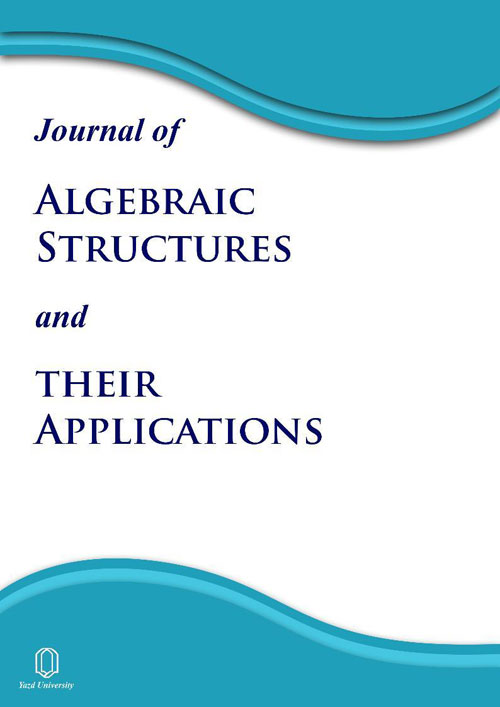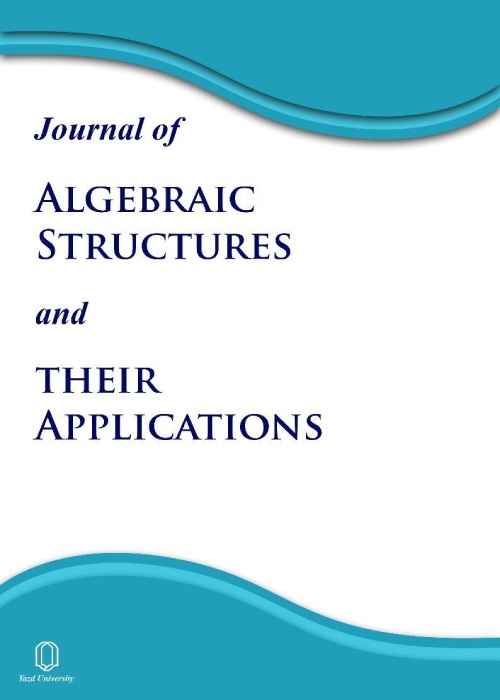فهرست مطالب

Journal of Algebraic Structures and Their Applications
Volume:5 Issue: 2, Summer - Autumn 2018
- تاریخ انتشار: 1397/11/27
- تعداد عناوین: 6
-
-
Pages 1-13Let R be an associative ring with identity. A ring R is called reversible if ab=0, then ba=0 for a,b∈R. The quasi-zero-divisor graph of R, denoted by Γ∗(R) is an undirected graph with all nonzero zero-divisors of R as vertex set and two distinct vertices x and y are adjacent if and only if there exists 0≠r∈R∖(ann(x)∪ann(y)) such that xry=0 or yrx=0. In this paper, we determine the diameter and girth of Γ∗(R). We show that the zero-divisor graph of R denoted by Γ(R), is an induced subgraph of Γ∗(R). Also, we investigate when Γ∗(R) is identical to Γ(R). Moreover, for a reversible ring R, we study the diameter and girth of Γ∗(R[x]) and we investigate when Γ∗(R[x]) is identical to Γ(R[x]).Keywords: quasi-zero-divisor graph, zero-divisor graph, reversible ring, reduced ring, diameter
-
Pages 15-21Let L be a finite-dimensional Lie algebra. We say a subalgebra H of L is permutably complemented in L if there is a subalgebra K of L such that L=H+K and H∩K=0. Also, if every subalgebra of L is permutably complemented in L, then L is called completely factorisable. In this article, we consider the influence of these concepts on the structure of a Lie algebra, in particular, we obtain some characterizations for supersolvability of a finite-dimensional Lie algebra in terms of permutably complemented subalgebras.Keywords: Lie algebra, permutably complemented, completely factorisable, solvable, supersolvable
-
Pages 23-34For two graphs G
and H with n and m vertices, the corona G∘H of G and H is the graph obtained by taking one copy of G and n copies of H and then joining the ith vertex of G to every vertex in the ith copy of H. The neighborhood corona G⋆H of G and H is the graph obtained by taking one copy of G and n copies of H and joining every neighbor of the ith vertex of G to every vertex in the ith copy of H. In this paper, we define four new extensions of corona and neighborhood corona of two graphs G and H; named the identity-extended corona, identity-extended neighborhood corona, neighborhood extended corona and neighborhood extended neighborhood corona and then determine the spectrum of their adjacency matrix, where H
is a regular graph. As an application, we exhibit infinite families of integral graphs.Keywords: spectrum, corona, neighborhood corona, integral graphs -
Pages 35-43A graph is called integral if all eigenvalues of its adjacency matrix are integers. Given a subset S of a finite group G, the bi-Cayley graph BCay(G,S) is a graph with vertex set G×{1,2} and edge set {{(x,1),(sx,2)}∣s∈S,x∈G} . In this paper, we classify all finite groups admitting a connected cubic integral bi-Cayley graph.Keywords: Bi-Cayley graph, Integer eigenvalues, Irreducible representation
-
Pages 45-53In this paper, we define some new homomorphism-monotone parameters for hypergraphs. Using these parameters, we extend some graph homomorphism results to hypergraph case. Also, we present some bounds for some well-known invariants of hypergraphs such as fractional chromatic number,independent numer and some other invariants of hyergraphs, in terms of these parameters.Keywords: hypergraph homomorphism, independing number, clique number, chromatic number, fractional chromatic number
-
Pages 55-78An MI-group is an algebraic structure based on a generalization of the concept of a monoid that satisfies the cancellation laws and is endowed with an invertible anti-automorphism representing inversion. In this paper, a topology is defined on an MI-group G
under which G is a topological MI-group. Then we will identify open, discrete and compact MI-subgroups. The connected components of the elements of G
and connected MI-groups are also identified. Some features of the maximal MI-subgroups and ideals of a topological MI-group are investigated as well. Finally, some theorems about automatic continuity will be introduced.Keywords: MI-groups, Monoid, pseudoidentity elements, canonical MI-subgroup, Full MI-subgroup, Internal topology


